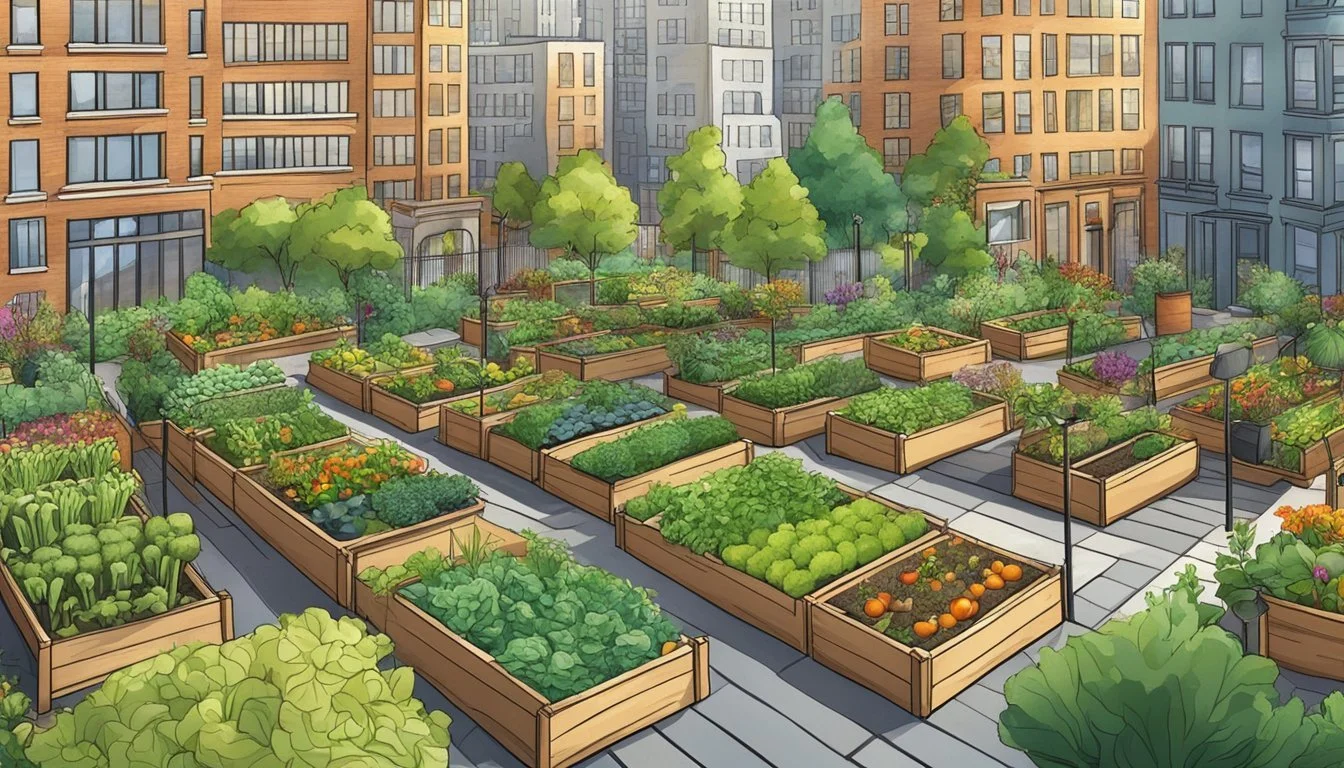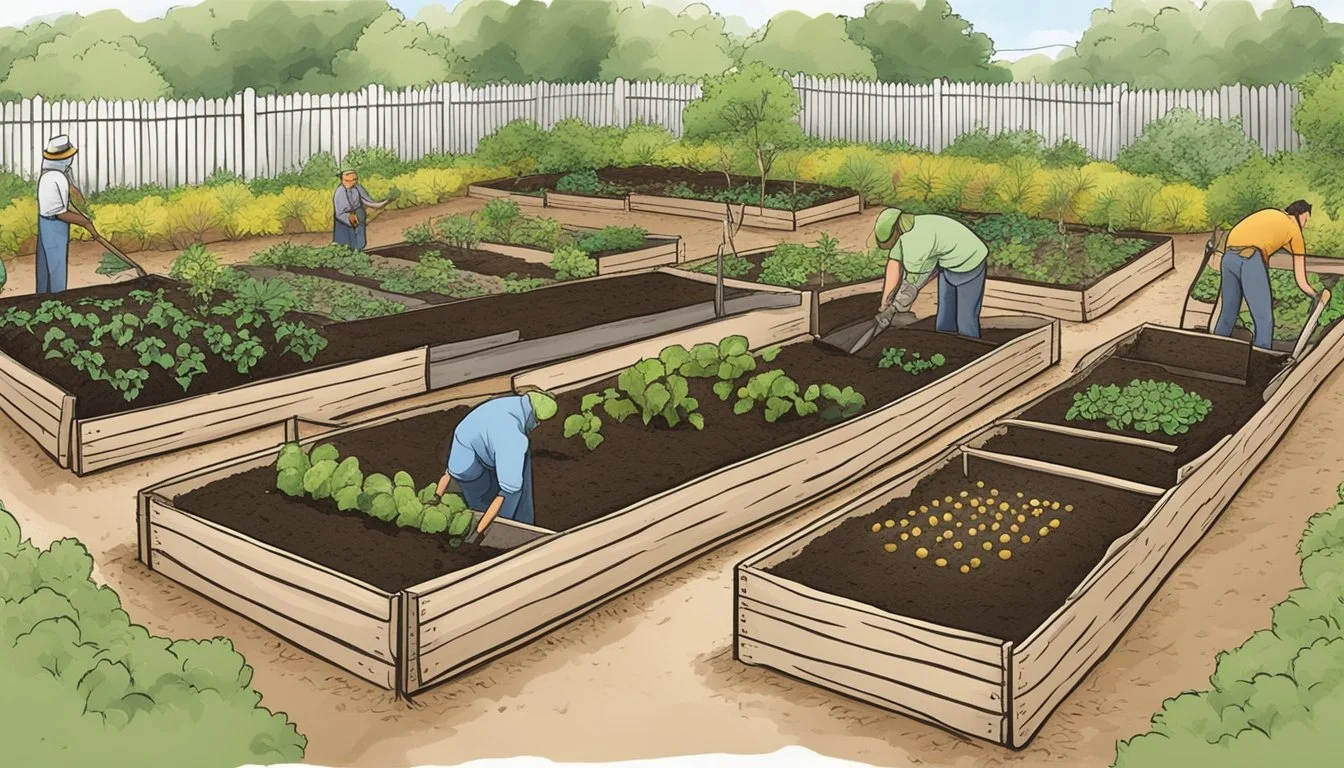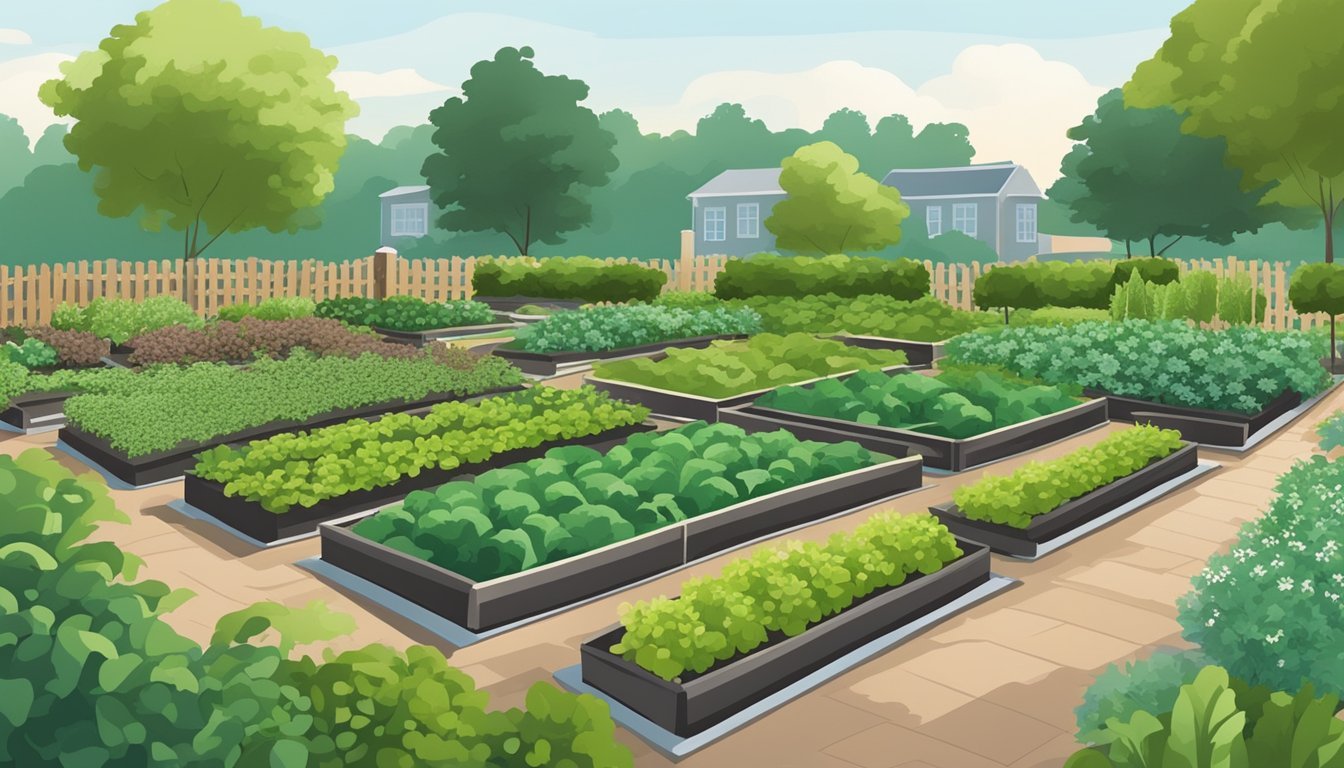Vegetable Gardening in New York
A Guide to Urban Cultivation Success
This Article is Part of Our Guide on Vegetable Gardening by State
Vegetable gardening in New York presents a unique set of challenges and rewards, making it a fulfilling endeavor for gardeners who understand the local climate and growing conditions. In a state known for its diverse weather patterns, gardeners can take advantage of the cool springs and falls to grow a variety of vegetables that thrive in those conditions. Lettuce, for example, is one vegetable that flourishes in New York’s colder months, demonstrating the region's suitability for cold-tolerant crops. Given the wide range of temperatures across the different regions of New York, gardeners must tailor their planting schedules to their specific local climate.
As the planting calendar varies across the state, New York gardeners need to be aware of their local first and last frost dates to maximize their growing season. Plant hardiness zones in New York range from 3-7, indicating a significant variance in what can be grown and when planting should occur. Starting seeds indoors is common practice for many spring vegetables that are not cold-tolerant, while summer and fall vegetables have their seeding and planting times set to avoid the extremes of summer heat and autumn frosts. Careful planning ensures a bountiful harvest from the garden, and knowledge of crop rotation, soil health, and pest management contributes to a successful growing season.
Understanding New York's Climate
New York State's diverse climate zones impact vegetable gardening significantly, from variable weather patterns to distinct USDA hardiness zones, and key frost dates.
Weather Patterns and Their Impact on Gardening
New York experiences a wide range of weather patterns, influenced by factors like the Atlantic Ocean and the Great Lakes. Places like New York City and Long Island have relatively mild winters due to the Atlantic, whereas cities such as Buffalo and Watertown are subject to heavy snowfall because of the Great Lakes' effect. In areas like Albany, Rochester, Syracuse, and Lake Placid, gardeners must navigate variable winter conditions and a shorter growing season due to cooler temperatures.
Typical Weather Conditions by Region:
New York City: Mild winters, hot summers
Buffalo: Snowy winters, moderate summers
Watertown: Long, snowy winters
Lake Placid: Cooler temperatures year-round
Gardeners must adjust planting schedules and crop selections in accordance with these weather patterns to ensure a successful harvest.
USDA Hardiness Zones in New York
New York's gardening zones range from 3 in the northern regions to 7 in the southern parts. This classification helps gardeners determine plant resilience in different areas.
Hardiness Zones in Key Cities:
Albany: Zone 5b
Buffalo: Zone 6a
Rochester: Zone 6b
Syracuse: Zone 5b
Lake Placid: Zone 4a
New York City: Zone 7b
Understanding these zones is crucial for selecting appropriate plants that can thrive in the state's varied climates.
First and Last Frost Dates
Monitoring frost dates is essential for planting and harvest times. The first frost in fall and the last frost in spring are two critical data points that can vary significantly across New York.
Approximate Frost Dates:
New York City: Last frost in early April; first frost in early November
Albany: Last frost in late May; first frost in mid-October
Buffalo: Last frost in mid to late May; first frost in mid-October
Syracuse: Last frost in late May; first frost in late September
Gardeners must consider these dates when planning their gardening activities to avoid crop damage from freezing temperatures.
Planning Your Vegetable Garden
To ensure a successful harvest, gardeners in New York must consider the state's unique climate and urban landscape when planning their vegetable gardens.
Selecting Suitable Vegetables
Climate: Understanding New York's climate is crucial for selecting suitable vegetables. The state's distinct seasons influence the growing cycles, with cold-hardy vegetables like spinach and kale thriving in the early spring, and warm-season crops, such as tomatoes and bell peppers, best planted after the last frost date.
Spring Vegetables: Spinach, kale, peas
Summer Vegetables: Tomatoes, bell peppers, cucumbers (how long do cucumbers last?)
Fall Vegetables: Broccoli, carrots, beets (how long do beets last?)
Garden Layout and Design
Sun Exposure: A successful vegetable garden in New York requires planning for optimal sun exposure. Most vegetables need at least 6 to 8 hours of direct sunlight. Arranging taller plants towards the north side of the garden prevents shading of smaller plants.
Crop Rotation: Implementing crop rotation is advisable to avoid soil depletion and minimize disease and pests. Diverse planting within the garden also encourages beneficial insects and improves overall plant health.
Urban Gardening Strategies
Urban gardeners in New York often face space constraints. They can maximize their limited space by:
Vertical Gardening: Utilizing trellises and hanging planters for crops like beans and tomatoes.
Intercropping: Planting faster-growing vegetables like radishes between slower-maturing plants.
Urban gardeners should also be aware of potential pollutants and address them by using clean soil and adequate drainage.
Raised Garden Beds and Containers
Raised Beds: Raised beds provide excellent drainage and improved soil quality, making them suitable for New York's urban settings and areas with compacted soil.
Containers: Container gardening allows for control over soil quality and is a versatile option for balconies and rooftops. Large, deep containers are preferred for root vegetables, while shallow ones are suitable for herbs and leafy greens.
Material: Wood, metal, or food-grade plastic
Depth: At least 6-12 inches for most vegetables; deeper for root crops
By considering New York's gardening conditions and applying these strategies, a gardener can create a productive and sustainable vegetable garden.
Soil Preparation
Preparing the soil is a fundamental step in starting a vegetable garden in New York. Proper soil preparation ensures that the plants have a strong foundation for healthy growth.
Testing and Amending Soil
Before any planting begins, it is crucial to test the soil to determine its pH and nutrient levels. Most vegetables thrive in soil with a pH between 6.0 and 7.0. Soil testing kits are available at garden centers or through local extension services. The results will guide gardeners on what amendments are needed to balance the soil pH and nutrient content. Common amendments include:
Lime or wood ash to raise the pH (make the soil more alkaline)
Sulfur or peat moss to lower the pH (make the soil more acidic)
Organic Matter and Fertilization
Incorporating organic matter, such as compost or well-rotted manure, into the soil is an effective way to enhance its structure and fertility. A 2-4 inch layer spread over the garden and tilled to a depth of about 6 inches will provide nutrients and improve soil drainage and aeration.
Organic fertilizers, while releasing nutrients more slowly, improve soil health over time. Common organic fertilizers and their primary nutrients include:
Blood meal: high in nitrogen
Bone meal: rich in phosphorus
Greensand: provides potassium
Using the right combination of organic matter and fertilizers tailored to the soil's needs will result in a nourishing environment for vegetable crops.
Planting Schedule
Proper timing is crucial when planting vegetables in New York. Gardeners should pay attention to the local frost dates and use a planting calendar as a guide for scheduling the planting of spring, summer, and fall vegetables.
Spring Planting Guide
Spring planting in New York revolves around the last frost date, which varies by location. Spring veggies such as lettuce, kale, and peas can be started indoors and transplanted following the last frost, typically from late March to early May. Direct seeding into the garden for hardier plants like radishes can occur as soon as the soil is workable.
Key planting dates for spring crops:
Late March to early April: Start seeds indoors for spinach, kale, and lettuce.
Mid to late April: Transplant or direct sow peas, spinach, and other cold-tolerant crops.
Early May: Transplant seedlings for tomatoes and peppers after the danger of frost has passed.
Summer Planting Guide
The summer planting schedule emphasizes on crops that thrive in New York's warmest months, which include beans, corn, and squashes. These are typically planted after the danger of spring frosts has passed and when soil temperatures have sufficiently warmed, usually from late May to June.
Key planting dates for summer crops:
Late May to early June: Direct sow seeds of beans, corn, cucumbers, and squashes.
Mid June: Plant heat-loving plants like tomatoes, peppers, and eggplants (What wine goes well with eggplant?).
Fall Planting Guide
Fall planting targets vegetables that mature well into New York's cooler months. Using the first frost date as a guide, typically mid-October, gardeners can work backward to determine planting times for fall veggies like broccoli and Brussels sprouts.
Key planting dates for fall crops:
Late July to early August: Sow seeds for broccoli, Brussels sprouts, and cabbage.
Mid to late August: Direct sow leafy greens like arugula and spinach.
Using a Planting Calendar
A planting calendar is a valuable tool for New York gardeners that lists optimal planting times based on local frost dates and growing seasons. It takes into account New York's varying climate zones and can substantially increase chances for a successful harvest. It is advisable to use an area-specific planting calendar that considers the state's diverse climate zones for the most accurate planting dates.
Vegetable Profiles
In the diverse climate of New York, vegetable gardening can be highly productive with a variety of species suitable for planting throughout the year. This section provides a concise overview of popular vegetables to grow in New York across different categories.
Leafy Greens
Leafy greens such as lettuce, spinach, kale, and chard thrive in New York's cooler temperatures. Lettuce varieties like Butterhead and Loose Leaf are cold-hardy and can even grow with some frost. Spinach and kale are also low-maintenance vegetables that can tolerate partial shade and cooler weather. Chard is valued for its ability to grow in both spring and fall.
Recommended Varieties:
Lettuce: Butterhead, Boston, Loose Leaf
Spinach: Bloomsdale Long Standing, Space
Kale: Lacinato, Winterbor
Chard: Bright Lights, Fordhook Giant
Root Vegetables
Root vegetables such as carrots, beets, and radishes are ideal for New York gardens due to their hardiness. Carrots and beets prefer well-drained soil and can be planted directly outdoors after the last frost. Radishes, one of the fastest-growing vegetables, can be sown several times throughout the growing season.
Sowing Guidelines:
Carrots: Sow seeds (how long do seeds last?) 3-4 weeks before the last frost; thin to 2 inches apart.
Beets: Sow seeds 1/2 inch deep; space rows 12-18 inches apart.
Radishes: Plant seeds 1 inch apart in rows, and begin harvesting as soon as they are sizeable.
Fruiting Vegetables
Popular fruiting vegetables like tomatoes, peppers, eggplants, and cucumbers require a warmer environment and should be started indoors before transplanting outside after the last frost. They need full sun and well-draining soil to produce a bountiful harvest.
Cultivation Tips:
Tomatoes: Support plants with cages or stakes to encourage upward growth.
Peppers: Space plants 18 to 24 inches apart in a sunny spot.
Eggplants: Keep soil consistently moist and provide extra compost for nutrient-hungry plants.
Cucumbers: Use trellising to save space and encourage straighter growth.
Legumes and Beans
Beans such as green beans and legumes like peas can also be successful in New York gardens. They are typically planted after the danger of frost has passed and the soil has warmed. These crops fix nitrogen in the soil, which can improve the soil health for future plantings.
Planting Recommendations:
Green Beans: Plant 1-inch deep and 2-4 inches apart; provide a trellis or poles for climbing varieties.
Peas: Plant 1 inch deep and 2 inches apart in both spring and fall for a continuous harvest.
Maintenance and Care
Successful vegetable gardening in New York involves consistent maintenance and attention to ensure the health and productivity of the garden. It's essential to understand the specific needs of each plant, as well as how to protect them from environmental stressors and threats.
Watering Requirements
Vegetables: Optimal watering practices are crucial for the growth and yield of vegetables. Different vegetables have varying water needs, but generally, one inch of water per week suffices. It's important to adjust watering based on rainfall to maintain this level. A simple rain gauge can help monitor the water vegetables receive from rain.
Frequency and Timing: Early morning is the best time to water, reducing evaporation losses and helping to prevent fungal diseases. For those who cannot water in the morning, late afternoon is an alternative, as long as leaves have time to dry before nightfall.
Managing Pests and Diseases
Pests: Common pests such as deer, rabbits, and squirrels may pose threats to New York gardens. Crop selection and protective measures like fencing can mitigate damage. Regular inspections for insect pests and timely interventions with eco-friendly pesticides or natural predators can also protect crops.
Diseases: Diseases often flourish in wet conditions. To manage garden health:
Promote good air circulation by spacing plants appropriately.
Avoid overhead watering to keep foliage dry.
Use disease-resistant varieties when possible.
Weed Control
Prevention: Mulching is an effective way to prevent weeds from taking over vegetable gardens. An organic mulch layer can suppress weed growth, retain soil moisture, and regulate soil temperature.
Removal: Regular weeding is necessary to prevent competition for nutrients and water. Hand-pulling weeds can be effective, especially when the soil is moist. Close planting can also reduce weed growth by shading the soil once crops have established.
Harvesting and Storing
Successful vegetable gardening in New York culminates in timely harvesting and appropriate storage to maximize flavor and longevity. One's efforts yield the best results when produce is picked at its peak and preserved with care.
Optimal Harvest Times
Root Vegetables: Carrots, beets, and potatoes are best harvested when the soil is dry. Carrots and beets typically reach their optimal size for harvesting two to three months after planting. Potatoes are ready when the tops die back and the skins toughen up.
Leafy Greens: Varieties like spinach and lettuce can be picked as soon as they reach a desirable size. Harvest in the morning for crispness and a fresh flavor.
Legumes: Snap beans and peas should be harvested when they are firm and can be easily snapped. They are typically ready four to eight weeks after planting.
Tomatoes, Peppers, and Eggplants: These should be picked when they have reached their full color and are slightly firm to the touch. They continue to ripen off the vine when stored properly.
Preservation Techniques
Canning: Suitable for tomatoes, cucumbers (as pickles), and beans, canning retains flavor and extends shelf life. Ensure jars are sealed correctly to prevent spoilage.
Freezing: Blanch vegetables like broccoli, corn, and peas before freezing. This stops enzyme action, preserving flavor and nutritional value.
Drying: Herbs, onions, and peppers can be dried. They should be completely dry before storage to prevent mold.
Cool Storage: Root vegetables require a cool, humid environment. Store them in the dark to prevent sprouting.
Refrigeration: Certain vegetables, like leafy greens, should be refrigerated. Place them in perforated plastic bags to maintain humidity while allowing airflow.
Extending the Growing Season
Gardeners in New York can extend their growing season by starting with transplants and utilizing protective structures. These methods can effectively shield crops from early frost and utilize microclimates for a more extended harvest.
Using Transplants
Starting with transplants rather than direct seeding gives plants a head start, as they are sown indoors and then moved to the garden after the last frost date. Transplants offer a significant advantage because:
They can be grown in controlled conditions, shielded from variable weather.
Gardeners can time transplants for optimal outdoor planting dates, avoiding late frost damage.
Cover crops like legumes, planted and then tilled into the soil before transplanting, can improve soil health and warmth, creating a more hospitable environment for the young plants.
Protective Structures
Protective structures range from simple cloches to sophisticated greenhouses. They create microclimates that provide vegetation with warmth and protection throughout unpredictable weather periods. Here are some typical structures used:
Cold Frames: Simple wooden boxes with a clear lid, trap heat without requiring any external energy. They're ideal for hardening off transplants.
Hoophouses: Arched frames covered with plastic provide an intermediate solution that offers more space than cold frames but less than greenhouses.
Greenhouses: Offer the most protection and can even allow for year-round growing for certain crops.
By using these techniques, one can significantly prolong the productive period of a New York vegetable garden.
Resources and Community Support
Accessing resources and community support can greatly enhance the success and reach of vegetable gardening initiatives in New York. The following resources provide valuable support for gardeners in terms of educational programming, local expertise, and fostering a sense of community in urban agricultural practices.
Cornell Cooperative Extension
Cornell Cooperative Extension (CCE) offers a vast network of support for gardeners across New York counties. This organization provides research-backed resources and education to help citizens effectively manage their home gardens, taking into account the local weather and other regional considerations.
Educational Services: CCE delivers workshops and offers guidance on sustainable gardening practices tailored to New York's varied climates.
Community Outreach: Through the CCE, experts are available to provide hands-on assistance and troubleshoot gardening challenges, beneficial for areas like Elmira and beyond.
Local Gardening Communities
A thriving array of local gardening communities exist throughout New York to support vegetable gardening enthusiasts.
Community Gardens: Local organizations operate gardens in urban areas, creating green spaces and offering plots for residents to cultivate their own vegetables.
Example: The GreenThumb Community Gardens initiative in New York City provides a directory of such spaces across five boroughs—Bronx, Brooklyn, Manhattan, Queens, and Staten Island.
Peer Support: Local gardening communities often foster peer learning and sharing of best practices, which is vital for new and experienced gardeners alike.
Networking Opportunities: Joining these communities affords gardeners the chance to network, receive community support, and share resources.









